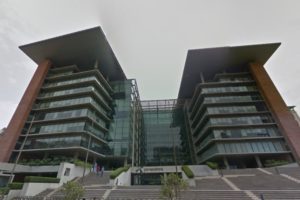Protesters broke into the heavily guarded compound of the US Embassy in Baghdad on Tuesday and set fires inside in anger over US airstrikes that killed 24 members of an Iranian-backed militia over the weekend.
The men did not enter the main embassy buildings and later withdrew from the compound, joining thousands of protesters and militia fighters outside chanting “Death to America,” throwing rocks, covering the walls with graffiti and demanding that the United States withdraw its forces from Iraq.
The situation remained combustible, with the crowd vowing to camp indefinitely outside the sprawling compound, the world’s largest embassy. Their ability to storm the most heavily guarded zone in Baghdad suggested that they had received at least tacit permission from Iraqi security officials sympathetic to their demands.
President Donald Trump, faced with scenes of unfolding chaos at a US Embassy, lashed out against Iran, which he blamed for the protests.
“Iran will be held fully responsible for lives lost, or damage incurred, at any of our facilities,” he said in a tweet. “They will pay a very BIG PRICE! This is not a Warning, it is a Threat. Happy New Year!”
He also spoke with Prime Minister Adel Abdul-Mahdi about the need to protect Americans and US facilities, a White House statement said.
Speaking with reporters in an impromptu exchange Tuesday night at his Mar-a-Lago estate in Florida, Trump said he thought his administration had handled the situation in Iraq “very well.” Trump added, “I want to have peace, I like peace. And Iran should want peace that more than anybody.”
Roughly 750 additional US troops will deploy to the region immediately, Secretary of Defense Mark Esper said late Tuesday. “This deployment is an appropriate and precautionary action taken in response to increased threat levels against US personnel and facilities,” he said. The troops are likely to deploy to Kuwait.
Trump has long called for an end to US conflicts in the Middle East, but has been reluctant to pull troops from the region despite his remarks on the campaign trail.
Secretary of State Mike Pompeo also spoke by telephone with Abdul-Mahdi and President Barham Salih in separate calls, and “made clear the United States will protect and defend its people,” according to a summary of the call from the State Department. It said that the Iraqi leaders “assured the secretary that they took seriously their responsibility” to safeguard American officials and property.
The State Department said that American personnel were safe and that there were no plans to evacuate the embassy. The ambassador, Matt Tueller, had been traveling and was not at the embassy when it was breached Tuesday.
The US airstrikes Sunday have resulted in the most serious political crisis in years for the United States in Iraq, stoking anti-Americanism and handing an advantage to Iran in its competition for influence in the country.
The airstrikes targeted an Iranian-backed Iraqi militia, Kataib Hezbollah, which the United States accused of carrying out a missile attack on an Iraqi military base that killed an American contractor and wounded American and Iraqi service members. A spokesman for the militia denied involvement in the attack.
But the size of the US response — five strikes in Iraq and Syria that killed two dozen fighters and wounded dozens of others — prompted condemnation from across the political spectrum in Iraq and accusations that the United States had violated Iraqi sovereignty. It also drew sharp criticism and serious threats of reprisals from Iraq’s Iranian-backed militias.
The fact that the Iraqi government permitted militia members to enter the fortified Green Zone on Tuesday, allowing the protest to happen, demonstrated Iran’s powerful influence as well as the government’s difficulty in controlling the militias.
But the Iraqi leadership’s success in averting a deeper incursion into the embassy compound and preventing any confrontation with American personnel suggested that the government may have intended to allow the militias to vent their anger with minimal damage.
The US military made a show of force in response to the turmoil, with helicopter gunships circling overhead. From inside the compound, loudspeakers warned the crowd outside to keep away from the walls.
The Pentagon sent 120 Marine reinforcements to Baghdad from Kuwait, roughly the same number sent to the embassy in 2014, when the Islamic State was threatening Baghdad.
The protest began Tuesday morning when thousands of militia members gathered outside the Green Zone after prayer services for the fighters killed in the US strikes.
While few of them were armed, many were members of Kataib Hezbollah and other fighting groups that are technically overseen by the Iraqi military. Kataib Hezbollah is separate from the Hezbollah movement in Lebanon, although both groups are backed by Iran and oppose the United States.
When the protesters pushed toward the entrance to the Green Zone, a heavily guarded district of government offices and embassies in central Baghdad, the Iraqi security forces did not stop them.
Their accession to the protesters was a marked contrast to their treatment of the anti-government protesters who have been demonstrating outside the Green Zone for months. Those protesters were met with tear gas and bullets and have not been able to enter the Green Zone.
Once at the US Embassy, the protesters on Tuesday used long poles to shatter security cameras. They covered the compound walls with anti-American graffiti and set a guardhouse on fire.
After breaking open a compound entrance, dozens of men entered and lit more fires while embassy security guards watched them from the embassy roof and fired tear gas.
One group of protesters ended up separated from US troops by only a pane of glass, according to a video shared on social media. It was not immediately clear how many Americans were inside the compound, but officials said they sheltered in place and were unhurt.
The protesters eventually left the Baghdad compound, but some climbed on top of adjacent buildings, where they planted militia flags. Iraqi police and military personnel eventually arrived at the scene, but they did not disperse the protesters.
The Iraqi interior minister, Yassin al-Yasiri, said in an interview near the embassy that US attacks on an Iraqi militia had invited trouble.
“These are the dangerous ramifications of this strike,” he said. “What happened today is the danger that we were afraid of, and that the Americans should have been afraid of.”
While the protesters carried the flags of Iraq and a range of militia groups, the most prominent was that of Kataib Hezbollah, the group targeted by the United States.
A spokesman for Kataib Hezbollah, Mohammed Muhi, said his group intended to erect tents in the street in front of the US Embassy for an opened-ended sit-in to pressure the Americans to leave Iraq.
“We will not leave these tents until the embassy and the ambassador leave Iraq,” Muhi said.
About 1,000 militia members remained camped out in front of the embassy overnight.
The upheaval comes at a critical time for Iraq and for the United States’ role in the country. Mass protests in recent months against poor governance have weakened the government and underscored the criticism of Iraqis who feel that Iran has too much sway over the country’s politics.
At the same time, Iran and the United States have been competing for political influence in the aftermath of the battle against the Islamic State group, which once ruled large areas of Iraq.




















